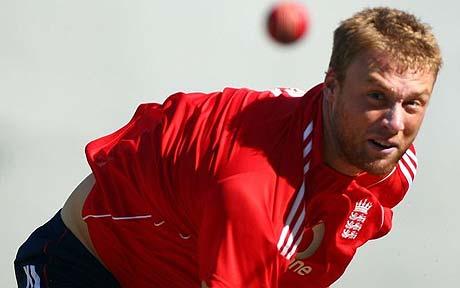 Andrew Flintoff, known around the cricketing world as ‘Freddie’, after the Flintstone’s character, finished his Test cricket career with a resounding victory over the Australians in the 2009 Ashes series.
Andrew Flintoff, known around the cricketing world as ‘Freddie’, after the Flintstone’s character, finished his Test cricket career with a resounding victory over the Australians in the 2009 Ashes series.
It was often suggested that Ian Botham had the ability to write his own script on the cricket field, if there was ever a script for Fred to write, it was to go out of Test cricket with an Ashes victory over the old enemy, Australia, on home soil.
Many promising young cricketers were drowned by the weight of the millstone of the ‘next Ian Botham’, as the weight of expectation was tied to their ankle and they were thrown into the local lake, never to be seen again.
Andrew Flintoff to his credit, has managed to forge a successful international career whilst being himself, not weighed down by England’s expectation, the likely lad from Lancashire has been true unto himself throughout.
Even if it did mean a couple of drinks too many on the odd occasion.
Flintoff grew up in Preston in Lancashire, a county with a passionate and vibrant cricket culture, for many years one of English cricket’s most revered battles was the ‘Roses Match’ with traditional and historical rivals, Yorkshire.
It’s a part of England shaped by its geography and history, its people have a strong identity, a Northerner is strong of opinion and lives life to the full.
The history of the working men and women of Lancashire is one of factories, coal pits and cotton mills, long hours and living life hard on the weekend, after a weeks toil.
Its men folk tend to enjoy the local delicacies of fine beer, pies and hot pot. I know, I grew up in North Lancashire as a lad in senior school.
Andrew Flintoff was identified as an exceptional and gifted youngster. He moved through the junior ranks of English cricket, into the full Lancashire side, a mighty striker of the ball and a medium fast bowler with potential not yet matched by speed or hositility.
Physically imposing at 6’4 it took time and plenty of conditioning work to fill out his tall, but plump frame.
After the tragic death of Ben Hollioake, Flintoff was accelerrated into the England allrounders breach at the age of twenty, although it would be some time before performances and fitness became international in standard.
Andrew Flintoff’s Mental Game
 By the mid 2000’s, Flintoff was bowling at 90mph (150kmh) consistently, with this speed and utilizing the natural gift of his height, his basic strategy evolved into holding back of length and wear batters down.
By the mid 2000’s, Flintoff was bowling at 90mph (150kmh) consistently, with this speed and utilizing the natural gift of his height, his basic strategy evolved into holding back of length and wear batters down.
Not just with unerring accuracy and pressure, but fear, consistent speed and control play on a batters mind. They can’t score and yet with the bounce and speed there is always the background noise of danger, 90 mph bouncers whistling past the visor.
The control which Flintoff developed allows him to control scoring areas on the field, you can call these ‘pressure zones’, where the fielding captain and bowlers control scoring areas, making strike rotation and boundary hitting very difficult.
Flintoff’s game strategy for batting was a reflection of his personality, carefree and adventurous.
An average of 32 was modest return for the talent and yet for entertainment value Flintoff could be breathtaking.
The basic modus operandi is to attack and then attack again, the strategy reflecting the risk to reward ratio of his game plan.
With many right brain dominant athletes they live in that spacey place where the present moment is so powerful that it outweighs all else.
This isn’t a conscious thing, it is the neural connections in the athletes brain, they operate pre-dominantly from the right brain where analytical thinking and structure are subordinant to the situation presented by the present moment.
The reason why Andrew and many other athletes get themselves into trouble off field is because of this exact same issue, a lack of cause and effect thinking.
In cricket and sport this can be beneficial, responding instantly to a game situation, yet in life this can bring problems. Acting impulsively and then having to deal with the consequences later.
Andrew Flintoff: Bowling and Batting Technique:

Flintoff’s action is classified as straight on, a run through bowler, when he lands in the crease both feet point down the pitch. The bowler must accelerate through the crease in contrast to the side on bowler, who decelerates marginally as they get ready to jump into their bound.
His strengths are control and reverse swing, metronomic accuracy and hostility.
His ability to reverse swing the ball in two Ashes series victories has been central to the success of the campaigns.
Andrews batting technique is simple, stand tall, minimal foot movement and a huge front foot game. At times vulnerable to poor weight transfer, where he would leave his head and subsequently his weight behind when playing off the front foot, leading to dismissals behind the wicket.
Strong on the cut and pull, and like many big men, could be vulnerable to the head high short ball where the bounce keeps coming up underneath the batter.
In the field, Andrew Flintoff is a great athlete for a big man. amazingly agile with a great set of hands. He is a fielder who changes matches with the quality of his slip fielding.
Andrew Flintoff: Strength and Conditioning

Like many young cricketers who are big men, Andrew Flintoff had to grow and fill out his huge frame, and by his mid twenties he began to develop the type of conditioning that was to make him a formidable quick bowler.
Essential for a quick bowler of Andrew’s class is good cardiovascular conditioning balanced with speed work.
A favourite amongst conditioning coaches and quick bowlers is the 30 metre run though, where the bowler accelerates for 10 metres , holds speed for 10 metres and then decelerates for 10 metres.
They would do anywhere from 2-6 sets of ten run throughs, simulating a 5- 10 over spell.
Gym specific conditioning work would involve an off season strength programme targeting all the major muscle groups used in bowling quick, but in particualr the legs and core.
In season would be general maintenance work with cricket specific fitness coming through in game time.
Andrew Flintoff’s finest hours have come in Ashes victories against Australia.
The series victory in 2005 saw Andrew establish himself as a star on the world stage, against an Australian side with its full compliment of stars, his performance was compulsive viewing.
Flintoff was part of a four prong pace attack which consistently intimidated the Australians, he bowled with pace and hostility, backed up by some strong contributions with the bat.
In the Ashes of 2006-7, down under in Australia and encumbered with the distraction of the captaincy, his performances faltered and then stalled. It was a terrible return for such an entertaining and charismatic cricketer.
In 2009, coming back from injury yet again, he summoned the great scrpt writer within himself and wrote a rousing finale to not only the Ashes summer, but his test career.
He thundered in, obviously discomforted by injury, imposing his considerable presence and will on the Australians.
After being left out in the second to last test of the series, he was back for the last test at the Oval. Flintoff returned, talismanic, running out Ricky Ponting to seize the moment and the impetus of the match. The series was Englands.
Having hung up the whites, Flintoff has embarked on a specialist short form career and is at the time of writing, rehabing again to be able to continue his career. We wish him well.
Back From Andrew Flintoff To Cricket Players

About Richard Pybus
I'm Richard Pybus, I've coached Pakistan, Bangladesh, Middlesex, Titans and the Cape Cobras in South Africa and the goal of this site is to help you to play winning cricket.
